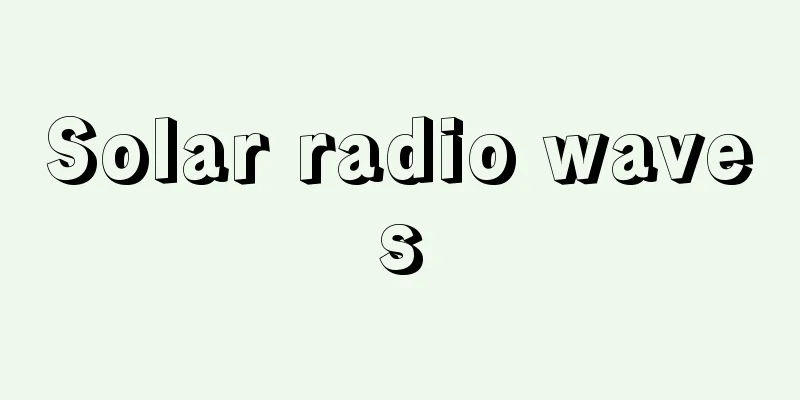Solar radio waves

|
The sun emits electromagnetic waves over a wide frequency range, of which radio waves are a part. Radio wave radiation is mainly caused by the accelerated motion of electrons in the solar atmosphere. The surface of the Sun is called the photosphere, and its temperature is about 6000K (Kelvin). Above it lies the thin chromosphere, which is 10,000K, and beyond that lies the corona, which is 1 millionK. The Sun is mainly made up of hydrogen, and in the high-temperature solar atmosphere, charged electrons (-) and protons (+) are in a plasma state, separated from each other. When these electrons collide with protons or spiral through the magnetic field, they emit radio waves due to their acceleration. In addition, there are sunspots on the surface of the Sun, which, due to their strong magnetic field, emit strong radio waves. Using these radio wave emission mechanisms, research is being conducted on explosions (solar flares) that occur in the solar atmosphere and near sunspots. There are two main types of devices that observe solar radio waves (solar radio telescopes): radiometers and radiographs. Radiometers are devices that measure the strength of radio waves emitted from the entire surface of the sun. They consist of a parabolic antenna (rotating parabolic mirror antenna) and a receiver, and are relatively easy to make and use. They observe radio wave strength at various frequencies and are used to study high-energy electrons generated by solar flares. Spectrometers that can observe at a continuous range of frequencies are called spectrometers. Radiographs are telescopes that use radio photography to observe the distribution of radio wave strength on the solar surface. To observe in detail, a device with good resolution is required. The resolution of a telescope is determined by the ratio of the wavelength of the electromagnetic waves being observed to the aperture of the telescope, so a very large aperture telescope is required for radio waves with a longer wavelength than light. However, it is difficult to realize a radio telescope with an aperture of more than several hundred meters, so small parabolic antennas are placed over a distance of several hundred meters, and the received radio waves are interfered with to essentially create a telescope with a length of several hundred meters. This is called a radio interferometer, and it allows us to observe the ever-changing distribution of radio wave intensity on the surface of the Sun. In the field of solar radio waves, Japan has the world's most advanced observation equipment and leads research. The Nobeyama Radioheliograph, which has been in operation since 1992, is a radio photographic instrument consisting of 84 parabolic antennas with a diameter of 80 centimeters arranged in a T-shape measuring 490 meters east-west and 220 meters north-south, and can take 10 sets of radio photographs per second at 17 and 34 gigahertz. Research on the sun is being conducted by comprehensively analyzing not only radio waves but also X-ray and ultraviolet observation data from artificial satellites, and light observation data from ground-based telescopes. [Kiyoto Shibasaki] With the closure of the Nobeyama Solar Radio Observatory at the end of March 2015, the radioheliograph was handed over to the Nagoya University Institute for Global Environmental Studies and is now operated under an international consortium. [Editorial Department, July 19, 2017] "Modern Astronomy Lectures Vol. 11: Observation of the Universe 1 - Observations by Light and Radio Waves" edited by Nishimura Shiro and Kaifu Norio (1981, Koseisha Kouseikaku)" ▽ "How Scientific Discoveries Have Been Made - The Dreams and Desires of Astrophysicists" by Sakurai Kunitomo (1997, Nippon Hyoronsha)" ▽ "The Sun - Its True Nature and Its Relationship to the Global Environment" by R. Lang Kenneth, translated by Watanabe Takashi and Sakurai Kunitomo (1997, Springer-Verlag Tokyo)" ▽ "The Universe of Radio Waves" by Maeda Koichiro (2002, Coronasha)" [References] | | | | | | | | | | waves|Radio | | | | |A radio telescope for observing the sun. 84 parabolic antennas, each 80 cm in diameter, form a radio interferometer with a diameter equivalent to 500 m. Minamimaki Village, Minamisaku District, Nagano Prefecture © National Astronomical Observatory of Japan"> Nobeyama Radioheliograph Source: Shogakukan Encyclopedia Nipponica About Encyclopedia Nipponica Information | Legend |
|
太陽からは広い周波数帯域にわたって電磁波が放射されており、電波もその一部である。電波の放射はおもに太陽大気中の電子の加速度運動によるものである。 太陽表面は光球とよばれ、温度は約6000K(ケルビン)である。その上空には薄い1万Kの彩層、さらにその外には100万Kのコロナがある。太陽はおもに水素からなっており、これら高温の太陽大気中では電荷をもった電子(-)と陽子(+)が離れたプラズマ状態になっている。この電子が陽子と衝突したり、磁場のなかを螺旋(らせん)運動したりすると、その加速度のために電波を放射する。また、太陽表面には黒点があり、強い磁場を伴っているので、強い電波を放射する。このような電波放射機構を用いて、太陽大気や黒点付近で発生する爆発(太陽フレア)の研究が行われている。 太陽電波を観測する装置(太陽電波望遠鏡)は大きく二つに分類することができる。ラジオメーターと電波写真儀である。ラジオメーターは、太陽全面から放射される電波の強度を測定する装置で、パラボラアンテナ(回転放物鏡アンテナ)と受信機からなり、比較的簡単に製作でき、観測も容易である。さまざまな周波数で電波強度を観測し、太陽フレアで発生する高エネルギー電子の研究に利用される。連続した周波数で観測できるものをスペクトロメーターとよぶ。電波写真儀は、電波写真を用いて太陽面上の電波強度の分布を観測する望遠鏡である。細かく観測するためには分解能のよい装置が必要である。望遠鏡の分解能は観測する電磁波の波長と望遠鏡の口径の比で決まるので、光に比べて波長の長い電波では非常に大きな口径の望遠鏡が必要となる。しかし、数百メートル以上におよぶ口径の電波望遠鏡は実現がむずかしいので、小口径のパラボラアンテナを数百メートルにわたって配置し、受けた電波を干渉させて実質的に数百メートルの望遠鏡を合成する。これを電波干渉計とよぶ。これにより、時々刻々変化する太陽表面の電波強度分布を観測することができる。 太陽電波の分野において、日本は世界の最先端の観測装置を有し、研究をリードしている。1992年(平成4)から稼動している野辺山(のべやま)電波ヘリオグラフは、口径80センチメートルのパラボラアンテナ84基を、東西490メートル南北220メートルのT字型に配置した電波写真儀で、17ギガヘルツと34ギガヘルツで1秒間に10セットの電波写真を撮像することができる。電波だけではなく、人工衛星によるX線や紫外線観測データ、地上望遠鏡による光の観測データなどを総合的に解析することにより、太陽の研究が進められている。 [柴崎清登] 2015年(平成27)3月末の野辺山太陽電波観測所閉所に伴い、電波ヘリオグラフは名古屋大学地球環境研究所に引き継がれ、国際コンソーシアムのもとで運用されている。 [編集部 2017年7月19日] 『西村史朗・海部宣男編『現代天文学講座 第11巻 宇宙の観測1――光と電波による観測』(1981・恒星社厚生閣)』▽『桜井邦朋著『科学の発見はいかになされてきたか――宇宙物理学者の夢と欲望』(1997・日本評論社)』▽『R・ラング・ケネス著、渡辺堯・桜井邦朋訳『太陽――その素顔と地球環境との関わり』(1997・シュプリンガー・フェアラーク東京)』▽『前田耕一郎著『電波の宇宙』(2002・コロナ社)』 [参照項目] | | | | | | | | | | | | | | | |太陽観測を目的とした電波望遠鏡。直径80cmのパラボラアンテナ84基が、直径500m相当の電波干渉計を形成する。長野県南佐久郡南牧村©国立天文台"> 野辺山電波ヘリオグラフ 出典 小学館 日本大百科全書(ニッポニカ)日本大百科全書(ニッポニカ)について 情報 | 凡例 |
>>: Solar cell - taiyodenchi (English spelling) solar cell
Recommend
ästhetisches Erlebnis (English spelling) asthetisches Erlebnis
...From a psychological point of view, aesthetic ...
Carrier - Unsounin
A person whose business is to enter into a transpo...
Whale tow - Whale tow
…Generally, it is treated without distinction fro...
Mount Amanokaguyama
A small hill in the Asuka region of Nara Prefectur...
Electrophiles - Electrophiles
A chemical species that receives or shares electro...
Bag - Bag
A tool for storing and carrying personal items. Ma...
Trincomalee (English spelling)
A port city in northeastern Sri Lanka. The capital...
Azusa River
A river that flows through western Nagano Prefectu...
Sines
The industrial areas are concentrated along the c...
Struve, H. von (English spelling)
...The following six people are famous as astrono...
Flow - Nagashi
A term in Japanese music. Its meaning varies depen...
Jozan
[1] [Name] A shrub of the Saxifragaceae family. Na...
Schlemmer
German painter, sculptor, and stage designer. Born...
Edo Garrison - Edochindai
...the name of the army military organization in ...
Gunji Narita
A military man in the late Meiji period and devel...









